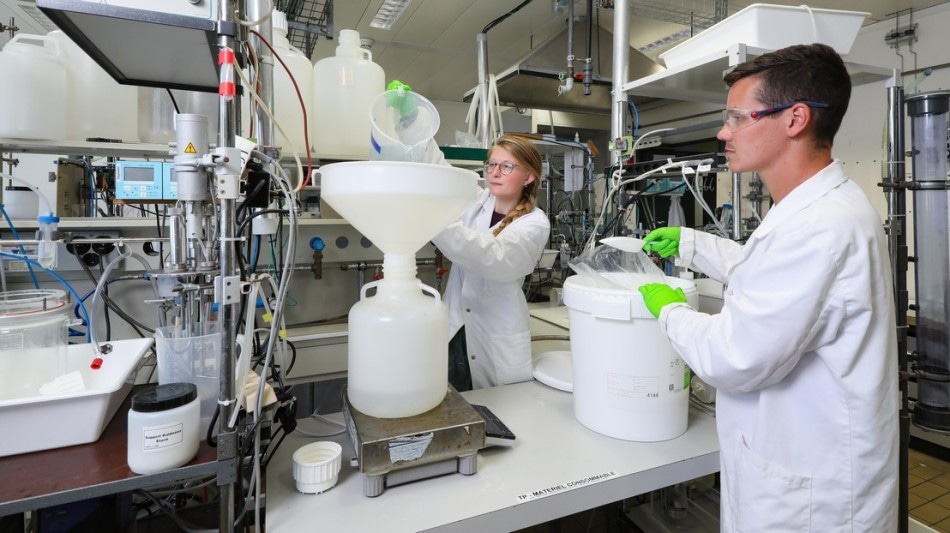Jul 18 2019
A new technique for recovering nitrogen from wastewater has been devised by two EPFL Master’s in Environmental Engineering students.
 (Image credit: EPFL)
(Image credit: EPFL)
As part of their semester project, Océane Hames and Lucas Ott, two Master’s students in Environmental Engineering at EPFL, modified a system usually used to concentrate fruit juice and tested it out at the Yverdon-les-Bains wastewater treatment plant in Vaud.
They opted to concentrate on the Yverdon-les-Bains wastewater treatment plant.
This plant is established as a pioneer in Switzerland since 2016 when it became the first in the country to set up a stripping membrane system for nitrogen recovery. These systems function by using a polypropylene membrane to filter the nitrogen from the remaining wastewater, once the effluent has undergone some initial processing.
Plants can minimize their nitrogen emissions into adjacent streams as well as synthesize a high-quality liquid fertilizer by stripping out the nitrogen in this manner. The fertilizer produced at Yverdon-les-Bains has been certified by the Swiss Federal Office for Agriculture; nearly 140 m3 are produced every year and sold to a local farmer who applies it on the crops, thereby fulfilling the nitrogen cycle.
However, Hames and Ott intended to make the nitrogen recovery process more effective by raising the fertilizer’s nitrogen concentration to more than 40 g/L, since that would minimize the cost of storing and transporting the fluid.
Inspired by the osmotic distillation method generally employed to concentrate fruit juice, the students created a technique particularly for nitrogen that could be included into current wastewater treatment processes.
They carried out lab experiments over many days to make the nitrogen concentration reach near its saturation point. In addition, they determined the flow rate of steam through the membrane to enable engineers to subsequently size the equipment required to execute the technology on a large scale.
Working Hand in Hand with Industry
The new osmotic distillation technique was tested by the students at a pilot unit offered by Membratec, a Sierre-based company that creates membrane technology for wastewater treatment.
The unit included pumps, two 25-L wastewater reservoirs, and two metallic cylinders consisting of a stripping membrane. They ran tests on the closed-loop system using a fluid which has the same composition as the fertilizer provided to the Vaud farmer.
Osmotic distillation has the advantage of being able to concentrate fruit juice at room temperature, meaning the juice’s taste and nutritional properties remain intact.
Océane Hames, Master’s Student, Environmental Engineering, EPFL
Ott added, “In osmotic distillation systems, a hydrophobic porous membrane lets gas compounds like steam pass through but not liquids. The driving force is generated by a partial vapor-pressure difference between the two fluids separated by the membrane. That’s the same mechanism we used to concentrate the nitrogen in the liquid fertilizer.”
Supplementing the Theory Learned in Class
Semester projects of this type, known as Design Projects, are necessary for all Master’s level environmental engineering students at EPFL. They are aimed to provide students first-hand experience of the R&D performed in industry.
I really liked the trial-and-error aspect of the project and the opportunity to discuss our progress week by week with a Membratec engineer.
Lucas Ott, Master Student, Environmental Engineering, EPFL
Hames stated that “It was nice to take a break from the classroom and spend the day running lab experiments. And it was really motivating to know that there could be a concrete application for the work we were doing.” The students’ project was overseen by Christof Holliger, a full professor at EPFL and head of the School’s Laboratory for Environmental Biotechnology (LBE).
Apart from the students, professors also gained from the project. According to Christophe Bonvin, who supervised their project at Membratec, it was a win-win experience: “We really enjoyed coaching the students. It’s impressive how much students can contribute when they’re motivated and well-guided, and when the scope of their projects is clearly defined.”